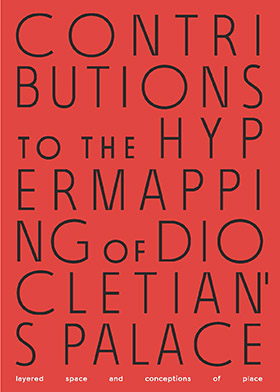Contributions to the Hypermapping of Diocletian’s Palace. Layered Space and Conceptions of Place

Publisher
Institut za povijest umjetnosti, Zagreb, 2023.
Authors
Damir Gamulin, Leslie Lok, Ana Šverko, Sasa Zivkovic
Editors
Anči Leburić, Leslie Lok, Ana Šverko
Executive Editor
Tomislav Bosnić
Reviewers
Joško Belamarić
Maja Furlan Zimmermann
Tadej Glažar
Ana Grgić
Ivana Mance
Goran Nikšić
Ivan Rupnik
Karin Šerman
Frano Violich
Translation
Sarah Rengel
Design and Layout
Damir Gamulin
Graphic Editor
Damir Gamulin
Proofreading
Tomislav Bosnić
Sarah Rengel
Printing and Binding
Sveučilišna tiskara d.o.o.
Material description
184 str.; ilustr.
ISBN 978-953-7875-64-0
A study that returns Diocletian's Palace in Split to the focus of theoreticians and the creative planning disciplines
Due to its transformative nature, where fragments or entire objects move from one spatial and/or chronological context to another, thereby becoming complementary and acquiring new meaning and value, Diocletian’s Palace in Split has held a strong appeal for both the modern, and in particular, the postmodern mentality. In recent decades, as the Palace became an icon of global tourism, burdened with the problems that this status brings, it gradually receded from the focus of theoreticians and creative planning disciplines. The essays gathered in this book investigate the Palace from a comparative perspective, one that resonates with its evolution as a dynamic place. Building on earlier research, the authors reexamine and discuss the Palace through the prism of the theoretical approach of the Collage City, the mat system, and temporal and intangible aspects of place and design. Given the tangible transformations’ impact on the intangible environment, and vice versa, Diocletian’s Palace serves as a valuable research model for contemporary architects, designers, conservators, and sociologists in both theory and practice.
Contents
10
Acknowledgements
12
Editor’s preface
20
Sasa Zivkovic
ULTIMATE COLLAGE CITY
Mat-Materiality and Constructed Collage in Diocletian’s Palace
52
Leslie Lok
FIGURE TO MAT
The Urbanism of Diocletian’s Palace
74 Ana Šverko
TIME—INCLUSIVE DESIGN
Exploring Diocletian’s Palace as a Model for Managing Change in Places
114
Damir Gamulin
THINKING SHADOWS, DRAWING PLACE
Translating Knowledge of Diocletian's Palace into Dynamic Design Guidelines and Constraints
174
Bibliography
180
About the Authors
From a review by Goran Nikšić
In “Ultimate Collage City”, Sasa Zivkovic proposes an original “re-reading” of the well-known architecture of Diocletian’s Palace through the prism of the theoretical approach of the Collage City, first defined by Colin Rowe and Fred Koetter. Considering its material transformations through recycling and reuse, Diocletian’s “multi-didactic Palace”, as Zivkovic suggestively calls it, presents a model for a wider discussion about circularity in the construction of future buildings and cities. The Palace, subtly and inspiringly interpreted in this essay as a dynamic archive, effectively advocates for an “ultimate” collage city – a city where collage concepts are iteratively applied throughout history, resulting in a blend of material conditions, narratives, and spatial circumstances.
From a review by Ana Grgić
In “Figure to Mat”, Leslie Lok intriguingly explores and interprets Diocletian’s Palace through the perspective of Smithson’s mat-building concept using the already tested comparative key metrics + program + place. The fact that the flexible theoretical framework of mat-building allows for the independence of this concept of the specifics of architectural expression, which means that the identification of mat-building is not subject to unambiguous code, clearly confirms that, even after several decades, references to Smithson’s concept are still highly relevant.
From a review by Frano Violich
The Lok and Zivkovic essays work excellently together, both with a reimagination of how Diocletian’s Palace transcends our understanding of what constitutes a “mat” condition. While Zivkovic discusses “matness” in the form of geological and later accreditive architectural collage, Lok “unpacks” the concept – the more urbanistic aspects of what it is to be mat-like.
From a review by Tadej Glažar
“Time–Inclusive Design” by Ana Šverko is a remarkable exploration of Diocletian’s Palace as a model for managing change in historical places, cities, and public realms, which implies minimal transformations of form. She successfully demonstrates how inclusive design principles can be applied to historical sites, promoting accessibility and inclusivity while respecting the site’s heritage. This essay is of utmost importance for contemporary processes in the city of Split and especially in its core, since our thinking, feeling, and acting affects the ways we view and change, conserve, or destroy our physical and spiritual environment as well as overall human relations. This essay is highly recommended for architects, urban designers, planners, historians, researchers of the humanities and anyone interested in the referential and experiential aspects of time in architecture, and explorations of architecture’s temporal dimensions.
From a review by Ivan Rupnik
“Thinking Shadows, Drawing Place” by Damir Gamulin sets out to frame the need for a methodology that balances preservation and intervention in a historically relevant structure, the core of Split, which grew out of the palace of the Roman emperor, Diocletian. The author utilizes shadow as a means with which to reframe the conversation around this complex urban environment (…) I see this essay as a prospectus for a research project connected to this work on Diocletian’s Palace that could result in some very relevant scholarship both for this particular site and for models of intervention in historically sensitive environments in general (…) This kind of research and scholarship is sorely lacking and desperately needed both globally and within the author’s immediate context.
-
Here you can download impressum, contents, excerpts from the reviews, acknowledgments, preface, and list of contributors (pdf, 4,6 MB).
-
This book has been supported by the funds of the Ministry of Culture of the Republic of Croatia, Ministry of Science and Education of the Republic of Croatia, and the City of Split.